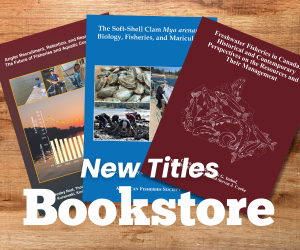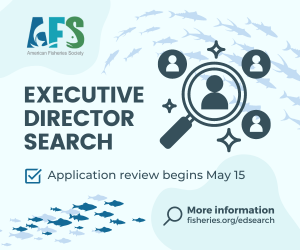Dudley W. Reiser, R2 Resource Consultants Inc., 15250 NE 95th Street, Redmond, WA 98052. E-mail: [email protected]
Remember the “which one doesn’t belong” puzzle? Try that out on the list of organizations in Table 1 and I would wager that most of us would point to the American Fisheries Society (AFS). Why? Well, AFS is mostly built around the advancement of sound science. Most of the others tend to be more harvest or conservation focused. Don’t get me wrong; their goals and objectives are laudable, and a visit to their websites attests to notable achievements. However, seeing AFS among these organizations just does not fit my vision of AFS as the leading fishery science organization in North America.
Since joining AFS in 1977, I have continuously relied upon its scientific journals and AFS Chapter, Division, and Society Annual Meetings and special symposia for the latest information in fishery science. I joined AFS while in graduate school because I thought it promoted development and application of objective, unbiased science that was not aligned with any cause and did not take sides on issues. I thought that was left to the more conservation-based organizations, such as those in Table 1. However,
over the past few years, AFS, as a whole, appears to me to have assumed more of an advocacy position, becoming more active in developing policy statements, letters, and resolutions on a variety of issues. Inspection of the AFS website under Policy Letters (https://fisheries.org/policy-media/policy-letters) reveals that more than 80 have been penned since 2007; I do not know how many had been drafted prior to then. However, as early as 1870, AFS (then the American Fish Culturists Association) advocated for a federal fish and fisheries agency for devoting fishing tackle federal excise taxes to states for developing and maintaining fisheries resources (Moffitt 2001).
In this article, which can be considered as an opposing view or counterpoint to others in this series, I want to share my thoughts on why I am less enthusiastic about and, yes, even concerned with the pathway of advocacy in AFS. I concede that to many members, taking a proactive approach is harmonious with their vision of AFS. It is perfectly understandable that AFS members feel a strong compulsion to have a voice on matters that pivot on technical issues to which they are well versed. However, I contend that leaning too much in this direction to the point where AFS becomes comfortable with advocacy not only runs the risk of reducing its scientific credibility but, in the long run, will change the public perception of AFS to that more closely aligned with other environmental conservation-based groups. And there are many such groups, albeit not all strictly focused on aquatic and fisheries issues. Like me, I suspect that many AFS members also belong to one or more of those nongovernmental organizations (NGOs). I personally applaud and support their efforts, provided that they are factually based and grounded in solid science. To me, those organizations are the perfect vehicles that we, as individuals, could and should use to voice concerns and advocate for or against particular projects, proposed legislative bills, or activities
having global consequence.
Is AFS an environmental NGO? Perhaps by definition yes, but to me, the answer is no because I have always separated scientific NGOs, such as AFS, the Ecological Society of America, and the Society of Ecological Toxicology and Chemistry, from environmental NGOs. The mission statements of Trout Unlimited and The Nature Conservancy are “to conserve, protect and restore North America’s coldwater fisheries and their watersheds” (tu.org/about-tu) and “to conserve the lands and waters
on which all life depends” (nature.org/about-us/vision-mission/ index.htm?intc=nature.tnav.about.list), respectively. Contrast this with the AFS mission statement “to improve the conservation and sustainability of fishery resources and aquatic ecosystems by advancing fisheries and aquatic science and promoting the development
of fisheries professionals.” To me there is an emphasis on science in the AFS mission statement, and that is where I think AFS should remain focused.
Do we even want to be considered an environmental NGO? My experience is that many NGOs comment on a project that potentially affects aquatic ecosystems by pointing to the past and citing examples where a particular type of project (e.g., dam construction, mining, logging) has had devastating impacts on the
aquatic resource, without carefully considering site and project specific information. This type of advocacy tends to be veiled in the name of science but is often incomplete, taken out of context, and selective. I think everyone would agree that the contemporary regulatory framework and our environmental awareness are
dramatically different from what existed in the past when many of what would become the most ecologically damaging projects were allowed to be constructed. Resource projects considered today must be designed to meet or exceed rigorous local, state, and federal environmental and regulatory requirements before they
can be developed. To me, it is fine to cite examples from the past when discussing potential impacts from a project if applicable, but these should be carefully formulated and balanced based on an understanding of site- and project-specific characteristics.
Consider also that AFS membership is composed of scientists representing diverse employer types—research, academics, government agencies, NGOs, tribes, municipalities, counties, technical consultants, fish culturists, and private industry. With this diversity, it is expected that the respective roles and responsibilities of staff will differ depending upon employer. Some will be more focused on resource conservation and sustainability, some on impact assessment and mitigation, and some on pure research. It is unrealistic to assume that AFS’s policy or advocacy positions will be equally embraced and supported by all of its members.
Of course, regardless of our employers, we as scientists should uniformly strive first and foremost to use the best available science no matter what the issue and to do so in an objective and unbiased fashion. As a fish consultant, I often work for a variety of clients, including government agencies, public and private utilities,
and developers. In all cases, I apply the same high-quality, science-based methods for conducting studies and analyzing data and, at the same time, avoid engaging in any type of an advocacy role for the parties. I may have a personal opinion regarding a particular project, but as a professional fisheries scientist, my role is to collect and analyze the best scientific data that can be used for evaluating project effects on fish and aquatic resources. Impacts are almost certainly identified as part of this process, which then calls for using the best available science and other information to develop protection, mitigation, and enhancement measures designed to reduce or eliminate those impacts. Our role as scientists does not stop just because results of studies may show project impacts. The ultimate goal of this work is to bring the best available
scientific information into the decision-making process.
I believe that when AFS becomes engaged with policy and advocacy positions that do not consider all available science and/or are not carefully reviewed, the science AFS purports to extol can become clouded. As Lackey (2007) noted, “To develop sound policy, science is important, helpful, perhaps even essential, but involvement with policy issues by a naive scientist or scientific organization can lead to loss of credibility and perceived independence unless the proper roles of both science and policy are understood and followed.”
A couple of examples where I think the AFS fell short or was premature in releasing particular position letters will highlight my concerns of advocacy. The first of these related to a lengthy letter submitted by the AFS Western Division (WDAFS) in March 2015 to the Federal Energy Regulatory Commission, the Governor of
Alaska, and state and federal representatives (http://wdafs.org/wp-content/uploads/2016/01/WDAFS_SusitnaLetter_Final.pdf). The letter declared that the proposed Susitna–Watana Hydroelectric Project, on which the Alaska Energy Authority was completing several years of extensive environmental studies, was both “economically and environmentally untenable” (p. 3). Because I was and continue to be involved in those studies, this letter struck a nerve and I responded with a 2016 letter back to the WDAFS (http://wdafs.org/wp-content/uploads/2016/01/DudleyReiser_WDAFSLtr3_27_15–2.pdf). In my response, I found the letter to be inconsistent with several Society guidelines, which the WDAFS follows, regarding policy and advocacy. Those guidelines are restated here and are available at https://fisheries.org/
policy-media/advocacy-guidelines. The guidelines that follow were designed to ensure that
• the Society’s external advocacy will be ethically and professionally
sound;
• advocacy will not degrade the Society’s reputation as the
most reliable source of scientific information on aquatic resources;
• fisheries-related scientific information will be used appropriately
when members address aquatic resource issues; and
• AFS advocacy positions will be widely supported within the
Society because they will be technically correct, respectful
of alternative views, and consistent with AFS policies and
the Code of Practices.
The WDAFS statement missed the mark on these guidelines in several ways. First, the assertion of the project being both “economically and environmentally untenable” was an overstep of the very first bullet (i.e., it was not ethically and professionally sound). Our role should be as scientists, not judges.
Second, related to bullet three, the WDAFS should have taken the time to become more familiar with the project and supporting data so it could appropriately use fisheries and scientific information before rendering its statement. The information needed to do so is readily accessible on the Alaska Energy Authority’s
website at www.susitna-watanahydro.org. Instead, the letter is replete with references to generic impacts of hydropower projects on fish and fish habitat and cites the Columbia River dams and the problems they have incurred for salmon. These types of comments are valid and useful for raising broad concerns and
identifying potential impacts of a project but should be supplemented with more site-specific information if available. Even a high-level review of the site-specific information for the proposed Susitna–Watana Hydroelectric Project would have revealed that it bears little resemblance to the Columbia River dams. For example,
the proposed Susitna–Watana project is for a single dam that would be located in the upper watershed (river kilometer 296) about 32.2 km above a natural geomorphic feature (Devils Canyon) that, based on results of radio-tagging studies conducted from 2012 to 2014, has been shown to allow relatively few Chinook Salmon Oncorhynchus tshawytscha (estimated at <0.5% of the total Susitna escapement for a given year) to successfully navigate through; none of the other anadromous salmon species (Sockeye Salmon O. nerka, Coho Salmon O. kisutch, Chum Salmon O. keta, and Pink Salmon O. gorbuscha) have been found above Devils Canyon. These findings are consistent with previous radio-tagging studies, including those conducted in the 1980s, in 2001, and from 2006 to 2010. Even so, fish passage is still being
evaluated for the Susitna–Watana Dam. In contrast, there are 14 dams on the Columbia River, the lower 9 of which contain fish passage facilities. Thus, the majority of anadromous salmon using the Columbia River system must pass at least one dam, some as many as nine, to reach destination habitats. These same nine
dams must likewise deal with difficulties associated with downstream passage of smolts. Size-wise, there is no comparison: the Columbia River has a drainage area of 668,216 km2 and an average discharge of 7,503 m3/s; the Susitna River, 51,799 km2 and 1,444 m3/s.
Third, related to bullet four, it was stated that Eulachon Thaleichthys pacificus in the Susitna River is listed as threatened under the Endangered Species Act. This is incorrect; the southern Distinct Population Segment of Eulachon that was listed extends from the Skeena River in British Columbia south to the Mad River
in California (http://www.fisheries.noaa.gov/pr/species/fish/ eulachon.html). This type of inaccuracy, which pertains to bullet two, can erode the AFS’s reputation as the most reliable source of scientific information on aquatic resources.
Another example occurred in a September 2014 Society letter supporting the U.S. Environmental Protection Agency’s restriction of mining within Alaska’s Bristol Bay Watershed via use of its 404(c) authority (https://fisheries.org/docs/wp/AFS-commentson-USEPA-Pebble-Mine-docket-EPA-R10-OW-2014–0505.pdf). I was working on the fish and aquatic studies associated with that project, so I am keenly aware of its controversy as well as some of the background information regarding the Environmental Protection Agency’s watershed analysis. In the letter, AFS appropriately provided substantial technical information regarding the potential impacts of mining and metals contamination on fish and proffered good recommendations regarding monitoring. However, AFS stepped beyond the ethical and professional advocacy guideline when it first named the engineering company involved in completing the preliminary designs for the Pebble Mine tailings dam and then associated the company with the design of the Mount\Polley tailings dam in British Columbia, Canada, that had recently failed. Several issues contradictory to AFS advocacy guidelines are apparent. First, as a point of reference, the Mount Polley Dam failure occurred on August 4, 2014, and the AFS comment letter was penned just over one month later on September 19, 2014, and well before any detailed investigations regarding the causes of the dam failure had been completed. This seems way too early to be assigning or even insinuating blame to any particular entity and certainly does not follow a scientifically rigorous process. Moreover, since the AFS letter submittal, there have been three completed technical investigations and one ongoing investigation of the breach. The most recent completed investigation was that by the BC chief inspector of mines (Hoffman 2015), who found that at the end of the named engineering company’s role as engineer of record, the perimeter embankment dam slopes
were nominally 1.8H:1V and the dam was stable. A further investigation is underway by the BC Conservation Office Service and other federal agencies. An additional point is that the statement in the AFS letter that “the modern Mount Polley Mine tailings dam is the same type of tailings dam proposed for Pebble Mine” clearly seems outside the technical limits of what AFS should be commenting on and, moreover, is pure conjecture, because to my knowledge, no specific design of a proposed tailings dam has been officially presented. A slightly more upfront investigation would have shown that since February 10, 2011, the named engineering company did not have responsibility or knowledge of any aspect of the subsequent design modifications or performance monitoring of the Mount Polley tailings facility that may have contributed further to its failure. The original engineering done by the company accommodated a significantly lower water volume than the tailings storage facility reportedly held at the time of the breach. My point here is that it is not necessary for AFS to bring in company names or make assumptions based on who is doing
the work when commenting on specific projects. In addition, AFS needs to restrain itself from being reactionary and forming opinions or jumping to conclusions in advance of detailed investigations. At all times, we should simply stick to the science.
So, how do we reconcile this intra-Society tension between members who take a pro-advocacy position from those who oppose doing so? I can think of four options worthy of consideration, each having positive (+) and negative (−) attributes.
• Option 1—We can cease to do it and focus on the science of
AFS and engage in advocacy outside of AFS through other
NGOs. After all, those NGOs need a clear and objective source
of credible fisheries information to tap into and AFS is ideally
suited to serve that function.
(+) Keeps the AFS centered on science and prevents inadvertent
oversteps of our primary mission statement.
(−) Would not serve members who firmly believe that
policy and advocacy fit within the framework of the AFS.
• Option 2—We can carefully regulate and control it from within
the AFS, with the imposition of stricter guidelines and a more
structured review process than what currently exists.
(+) Keeps policy and advocacy as an acceptable mandate
of AFS.
(−) Relies on development and strict adherence to procedures
(at the parent Society level) designed to vet all
policy and advocacy position statements prior to public
release; however, this still requires self-policing, and although
it reduces the risk of guideline infractions, it does
not eliminate them.
• Option 3—We can embrace it but separate it from the broader
membership by creating a Policy and Advocacy Section (similar
to Bioengineering, Education, Fish Culture, etc.) that members
are given the option to join (at no cost) that is devoted to
those activities.
(+) Keeps activities related to policy and advocacy separate
from the main mission of AFS and provides members
a choice in whether or not to participate in policy and advocacy
activities of AFS.
(−) Requires advanced planning and organization and an
active program of membership awareness before a new
section can be fully functional.
• Option 4—We can embrace it but separate it entirely outside of
the construct of the existing Society, via formation of a separate
science-based fish and fishery conservation organization
that can function autonomously from AFS.
(+) Keeps activities related to policy and advocacy completely
outside of AFS and preserves its reputation as a
strictly science-based organization.
(−) Requires the most work and uncertainty of the feasibility
of implementation.
I am sure that there are other options, and perhaps as an initial step, AFS should give serious consideration in formulating a plan to further define its policy and advocacy role, a part of which would be to evaluate these and other potential options. I would suggest that such a plan include canvassing its membership with the above options so that members can have a voice in how policy and advocacy issues are to be handled within AFS. Though the series of papers in this issue represents a diverse set of opinions on the topic that should to varying degrees align with those of the membership, there is no way of knowing the proportion of members who favor one approach over another without polling. Obviously, there will be differences of opinion regarding how to proceed and, in the end, AFS will need to select an approach that it believes best serves the entire membership but that, at the same time, is sensitive to differing perspectives on the topic. Even then, it would be naïve to think that all members will be equally served and comfortable with the approach. However, if the selected approach stems from the views of the members and the rationale for selection is clearly described and logically based, then AFS’s actions regarding policy and advocacy become transparent and more understandable to its membership.
In closing, I reflect on the comments of Boreman (2013:343), who said, “We cannot keep straddling the fence on the degree to which we advocate for fisheries conservation if we wish our Society to remain relevant to its membership.” I submit that AFS’s current actions indicate that it is already on the pro-advocacy side of the fence, whereas I and perhaps a few others are on the other side. The challenge now is how to get everyone on the same side of the fence, to ensure that most members are comfortable with Society actions or at least to fully recognize and be aware of what AFS is doing.
ACKNOWLEDGMENTS
I appreciate the critical reviews and comments of three anonymous reviewers; Bob Hughes, Guest Editor; and Gary Curtis, Fisheries Co-Chief Science Editor.
REFERENCES
Boreman, J. 2013. On behalf of the fish. Fisheries 38:343.
Hoffman, A. 2015. Mount Polley mine tailings storage facility breach. British Columbia Ministry of Energy and Mines, Mining and Mineral Resources Division, Victoria. Available: www2.gov.bc.ca/gov/ content/industry/mineral-exploration-mining/further-information/directives-alerts-incident-information/mount-polley-tailings-breach/mount-polley-investigation. (April 2017).
Lackey, R. T. 2007. Science, scientists, and policy advocacy. ConservationBiology 21:12–17.
Moffitt, C. M. 2001. Reflections: a photographic history of fisheries and the American Fisheries Society in North America. American Fisheries Society, Bethesda, Maryland.
Members click below for the July 2017 Fisheries magazine’s complete issue. Non-members, join here.
This content is for members only. Please login.





